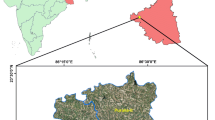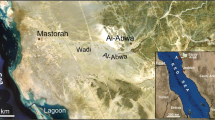Abstract
Geological and structural influences on groundwater flow and quality were evaluated in the present study in the hardrock regions of Tirunelveli District, southern India. Groundwater is a major source of freshwater in this region to cater to the requirements of domestic and agricultural activity, as there are no surface water resources. Geologically, the area is characterized by charnockites and garnetiferous biotite gneiss. Groundwater in this region is found to occur in the weathered portion under unconfined condition and in fractured/fissured portions under unconfined to semi-confined condition. Existence of deep-seated fractures are minimal. Lineaments/dykes play a major role in the occurrence and movement of groundwater in the region. Lineaments/dykes of the study area can be broadly divided into two types: north–south and west–east oriented structures. Analysis and field observations revealed that the north–south dykes act as a barrier of groundwater while the west–east oriented structures behave as a carrier of groundwater. Both quality and quantity of groundwater is different on the upstream and downstream sides of the dyke. Hence, it is conclusive that the west–east oriented dykes in this region are highly potential and act as a conduit for groundwater movement from recharge areas to the discharge area.







Similar content being viewed by others
References
Al-Taj M 2008 Structural control on groundwater distribution and flow in Irbid area, North Jordan; Jordan J. Earth Environ. Sci. 1 (2) 81–88.
Gibbs R J 1970 Mechanisms controlling world’s water chemistry; Science 170 1088–1090.
ISI (Indian Standards Institution) 1983 Indian Standard specification for drinking water, IS 10500.
Kunhambu V 1990 CGWB technical series report: Systematic hydrogeological surveys in parts of Tirunelveli-Kattabomman district; 52p.
Mondal S, Md Pandey A C and Garg R D 2007 Groundwater prospects evaluation based on hydrogeomorphological mapping using high resolution satellite images: A case study in Uttarakhand; J. Indian Soc. Remote Sens. 36 69–76.
Nag S K 2005 Application of lineament density and hydrogeomorphology to delineate groundwater potential zones of Baghmundi block in Purulia district, West Bengal ; J. Indian. Soc. Remote Sens. 33 (4) 521–529.
Nilsen K H, Sydnes M, Gudmundsson A and Larsen B T 2003 How dykes affect groundwater transport in the northern part of the Oslo Graben, EGS-AGU-EUG Joint assembly, Abstracts from the meeting held in Nice, France, pp. 6–11.
Perrin J, Ahmed S and Hunkeler D 2011 The effects of geological heterogeneities and piezometric fluctuations on groundwater flow and chemistry in a hard-rock aquifer, southern India; Hydrogeol. J., doi: 10.1007/s10040-011-0745-y.
Ramsahoy L E and Delang S M 1961 A simple method for determining specific yield from pumping test, U.S. Geological Survey Water Supply. Paper 1536 C.
Sampath Kumar E 1994 CGWB technical series report: Reappraisal: hydrogeological surveys in parts of Tambraparni and Nambiyar river basins in Tirunelveli and V.O. Chidambaranar district, 91p.
Senthilkumar M 2010 CGWB technical series report. Groundwater Management Studies: Identification of artificial recharge sites in water scarce areas in northern part of Tirunelveli district, southern India, 88p.
Srinivasa R Y and Jugran K D 2003 Delineation of groundwater potential zones and zones of groundwater quality suitable for domestic purposes using remote sensing and GIS; Hydrogeol. Sci. J. 48 821–833.
Vardaraj N 1984 CGWB technical series report: G.W resources and development potential of Tirunelveli-Kattabomman district, 65p.
Vasanthavigar M, Srinivasamoorthy K, Vijayaragavan K, Gopinath S and Sarma S 2011 Groundwater potential zoning in Thirumanimuttar sub-basin Tamil Nadu, India – A GIS and remote sensing approach; Geo-spatial Infor. Sci. 14 (1) 17–26.
Acknowledgements
Authors wish to thank the Chairman, CGWB, New Delhi for his permission to publish the research work. Thanks are also extended to Member, WQ & TT, Faridabad. The first author expresses his special thanks to Dr S Suresh, Sh V Dhinagaran, Dr K Ravichandran, and Sh N Rameshkumar, for the support and help rendered during the study.
Author information
Authors and Affiliations
Corresponding author
Rights and permissions
About this article
Cite this article
Senthilkumar, M., Arumugam, R., Gnanasundar, D. et al. Effects of geological structures on groundwater flow and quality in hardrock regions of northern Tirunelveli district, southern India. J Earth Syst Sci 124, 405–418 (2015). https://doi.org/10.1007/s12040-015-0538-0
Received:
Revised:
Accepted:
Published:
Issue Date:
DOI: https://doi.org/10.1007/s12040-015-0538-0




